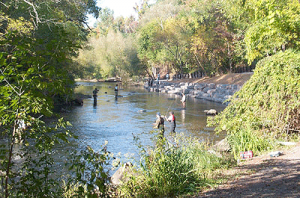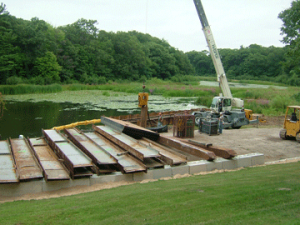
By Andrew Mcglashen
Environmental Health News
A most-wanted list of toxic substances–including PCBs, dioxins, mercury, lead and pesticides–has lingered in western New York’s Eighteenmile Creek for decades, leaving its salmon, trout and other fish unsafe to eat and jeopardizing its wildlife.
Now the nation’s sour economy has complicated and delayed the already daunting cleanup of the Lake Ontario tributary, as well as several dozen other toxic hotspots around the Great Lakes.
“Given the fiscal situation in the State of New York, it’s really up in the air if the cleanup will get done,”said Victor DiGiacomo Jr., who chairs a local group of landowners, officials and others aiming to restore the area.
Eighteenmile Creek, a meandering, lush stream in Niagara County known for its salmon and trout runs, is one of 43 highly contaminated sites that were designated “Great Lakes Areas of Concern” more than 20 years ago as part of a water-quality pact between the United States and Canada.
As a promise to expedite the cleanups, Congress passed the Great Lakes Legacy Act in 2002, and then last fall, reauthorized it for another two years. But the program remains hobbled by economic woes and bureaucratic hurdles, according to local officials involved in the cleanups.
“We’re essentially treading water. And if anything, we’re starting to go underwater,” said Jordan Lubetkin of the nonprofit Healing Our Waters —Great Lakes Coalition, which represents more than 100 environmental and community groups.
Of the mills and factories that riddled the Rust Belt with industrial pollutants, many have shut down or downsized, leaving the region hard-pressed to come up with the needed cleanup funds.
To make matters worse, most of the contaminated streams, harbors and other sites are so-called orphans, where those responsible for the pollution have died, gone bankrupt or are otherwise unavailable to pay their share.

Ruddiman Lagoon on Muskegon Lake Michigan, Great Lakes Commission
Chemicals in the sediment can cause reproductive problems in mammals, birds and aquatic life, and they become increasingly concentrated as they move through the food chains of ecosystems. State and federal officials have warned people not to consume fish from most water bodies around the Great Lakes. Some of the contaminants have been linked to cancer, neurological damage and other health problems in humans.
Dredging the contaminated sediments is likely to reach $1.5 billion to $4.5 billion at the Areas of Concern.
But Congress has not yet provided the funding recommended by an advisory group back in 2005. And the federal money that is available comes with a cost-sharing requirement that critics say is prohibitively high.
Nevertheless, Matthew Doss, policy director of the Great Lakes Commission, a binational agency, said officials have “started to make good progress under the Legacy Act.”
So far, five cleanups have been completed, removing more than 1.7 million pounds of contaminants, according to the Environmental Protection Agency. One U.S. area — New York’s Oswego River — has been delisted, as have two in Canada, and a major cleanup of Ohio’s Ottawa River was announced last month.
For a site to receive funding under the Legacy Act, a non-federal entity must first provide a minimum of 35 percent of the project’s cost. The five completed projects have cost states, local governments and private groups $44 million, the EPA says.
Finding that 35 percent “has always been a challenge,” Doss said. “I suspect it will continue to be so. The states have been in financial difficulty for many years.”
That’s the most significant roadblock in cleaning up New York’s Eighteenmile Creek, according to DiGiacomo.
“There are no entities capable of supplying that dollar amount,”he said.
Eighteenmile Creek–so named because it is 18 miles east of the Niagara River– offers important habitat for trout, steelhead, salmon and other fish as well as a threatened species, the Blanding’s turtle. The EPA has said contaminants there are likely to be causing bird and wildlife tumors and deformities. People eating its fish are at risk, too. Despite advisories against consuming the creek’s fish because of high levels of polychlorinated biphenyls (PCBs), the EPA says the area attracts roughly 15,000 anglers each year, particularly those flyfishing during fall salmon runs.
Cleanup is a similar struggle at southeast Michigan’s Clinton River, where PCBs, pesticides and other pollutants have triggered beach closings and fish consumption advisories, said Mark Richardson, who chairs the local cleanup committee.
“That’s a bigger problem than ever right now,” he said. “Obviously these cleanups are very expensive, and local governments certainly don’t have the wherewithal to supply matching funds on their own. That has stalled projects generally.”
In 2005, after meeting for a year, a 1,500-plus member advisory group called the Great Lakes Regional Collaboration, convened by Former President Bush, recommended that the 35 percent requirement be eliminated or reduced. The report said the matching fund requirement “for all practical purposes precludes the use of Legacy Act funds at those sites.”
However, the requirement remains in place.
David Cowgill of the EPA’s Great Lakes National Program Office in Chicago, declined to comment on why the requirement stands. But he stressed that the agency is looking for other ways to fund cleanups.
“We’re not exclusive in our thinking,” said Cowgill, the EPA program’s chief of technical assistance and analysis. “If it helps us achieve environmental protection, we’re interested.”
For example, Cowgill said, dredging toxic sediment might have the side effect of improving shipping lanes, so industry groups could benefit from chipping in. He also said state and local governments can meet their requirement with services, such as use of dredging equipment, instead of cash.
Other Areas of Concern contain registered Superfund sites, leaving them ineligible for Legacy Act dollars and forcing them to wait in a long line of backlogged projects.
“If we didn’t have Superfund here, then we would look to the Legacy Act,” said Jeff Spoelstra, head of the Kalamazoo River Watershed Council, which coordinates the remediation of that southwest Michigan stream. “But we actually have to wait in line for Superfund, which is a long process.”
Late last year, EPA completed the first major cleanup of the Kalamazoo’s PCBs since it was declared a Superfund site in 1990.
But after the $25 million removal of some 300,000 cubic yards of contaminated sediment, Spoelstra’s optimism was tempered by the enormity of what lay ahead.
“In the big picture of the site, that’s something like two percent of the sediment,” he said. “Given where the Superfund process is now, it will probably be upwards of 20 to 25 years”before the area is cleaned up to the point where it is removed from the Superfund list.
Then, in early January, Spoelstra got what he described as a punch in the gut when LyondellBasell Industries, which owns the paper companies responsible for remediation of the river, filed for bankruptcy.
It’s unclear how the bankruptcy would affect sediment removal on the river, but Spoelstra said it would likely put another significant obstacle in the already slow road to cleaning up the site.
“This program, it’s a frustrating one,” he said. “These sites have been known about for so long. We went decades without funding to clean up these Great Lakes black eyes.”
The Great Lakes Regional Collaboration’s 2005 report recommended annual spending of $150 million for 5 years for the Legacy Act. The House voted last September to reauthorize the act with spending boosted to that level, but the Senate cut the authorization to just two years at $54 million apiece, an annual increase of $4 million from past years.
So far, however, the act has not been funded above the $34.5 million spent in 2008.
Environmentalists had hoped President Obama’s federal stimulus package might be an opportunity to hasten the remediation process.
Lubetkin’s coalition asked Congress to include a $500 million addition to the Legacy Act over two years, saying it would create much-needed jobs and raise property values in affected areas. A report in the Journal of Great Lakes Research found a loss of property value of $118 million in New York’s Buffalo River area and $50 million near Wisconsin’s Sheboygan River due to contamination.
But Doss of the Great Lakes Commission said the sediment cleanup was seen as a region-specific earmark, so it was not part of the stimulus package.
Regardless, he said, much of the necessary planning and monitoring are complete at some sites, and he expects to see more tangible results soon.
“I think we’re gradually moving into a phase where we’ll see more on-the-ground cleanups,”he said.
Environmentalists say it’s crucial that Doss’s assessment prove accurate. Cleaning up the sites could get more expensive the longer pollutants remain, they say, since the sediment can be buried further or migrate into the Great Lakes.
“The toxic contamination will spread,” said Lubetkin. “At this point, status quo funding translates into the Great Lakes continuing to deteriorate.”
Pingback: Great Lakes toxic hot spots could get restoration boost from GLRI | Great Lakes Echo
Pingback: Great Lakes Echo» Blog Archive » EPA dioxin push could be a boon to Great Lakes cleanup
And for sites where there are responsible parties like the recalcitrant Dow Chemical, the economy and bureaucracy aside, cleanup has been hampered by politics, corporate influence and the utter unwillingness of the company to take responsibility. Dow’s dioxin legacy issue is 30 plus years old and every governor has kowtowed to the company. Without a doubt the fish in the Saginaw and Tittabawassee River are highly contaminated–Dow successfully staved off posting the rivers for two years by arguing about the language on the signs— makes hope for cleanup a long shot.
Dow has delayed or derailed existing timelines and agendas for 15 years. It took the state of Michigan 6 years (1996- 2001) to negotiate Dow’s RCRA corrective action license–then Dow behind the scenes during the Engler administration (2002) sought to undo that work with an illegal consent order. In 2004 Dow again in the Granholm administration delayed and derailed the RCRA timeline by going into secret negotiations with the Governor’s office. Here we are in 2009 and Dow with the Governor’s blessing is derailing the seven-year RCRA process as the company seeks another path forward under the Superfund Alternative guideline—this was requested in the waning months of the Bush administration.
The success of cleanup where an RPR exists is determined not by money or the economy but by politics. To date there is not one elected official willing to take on Dow Chemical.
In the meantime these highly contamintated sediments migrate to people, wildlife and Lake Huron. Where are the public defenders?